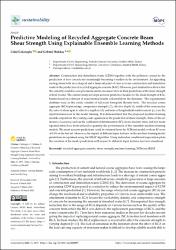| dc.contributor.author | Çakıroğlu, Celal | |
| dc.contributor.author | Bekdaş, Gebrail | |
| dc.date.accessioned | 2024-04-04T18:54:37Z | |
| dc.date.available | 2024-04-04T18:54:37Z | |
| dc.date.issued | 2023 | en_US |
| dc.identifier.citation | Çakıroğlu, C. ve Bekdaş, G. (2023). Predictive modeling of recycled aggregate concrete beam shear strength using explainable ensemble learning methods. Sustainability, 15 (9). | en_US |
| dc.identifier.uri | https://hdl.handle.net/20.500.12846/1035 | |
| dc.description.abstract | Construction and demolition waste (CDW) together with the pollution caused by the
production of new concrete are increasingly becoming a burden on the environment. An appealing
strategy from both an ecological and a financial point of view is to use construction and demolition
waste in the production of recycled aggregate concrete (RAC). However, past studies have shown that
the currently available code provisions can be unconservative in their predictions of the shear strength
of RAC beams. The current study develops accurate predictive models for the shear strength of RAC
beams based on a dataset of experimental results collected from the literature. The experimental
database used in this study consists of full-scale four-point flexural tests. The recycled coarse
aggregate (RCA) percentage, compressive strength (f
0
c
), effective depth (d), width of the cross-section
(b), ratio of shear span to effective depth (a/d), and ratio of longitudinal reinforcement (ρw) are the
input features used in the model training. It is demonstrated that the proposed machine learning
models outperform the existing code equations in the prediction of shear strength. State-of-the-art
metrics of accuracy, such as the coefficient of determination (R
2
), mean absolute error, and root mean
squared error, have been utilized to quantify the performances of the ensemble machine learning
models. The most accurate predictions could be obtained from the XGBoost model, with an R
2
score
of 0.94 on the test set. Moreover, the impact of different input features on the machine learning model
predictions is explained using the SHAP algorithm. Using individual conditional expectation plots,
the variation of the model predictions with respect to different input features has been visualized. | en_US |
| dc.language.iso | eng | en_US |
| dc.relation.isversionof | 10.3390/su15064957 | en_US |
| dc.rights | info:eu-repo/semantics/openAccess | en_US |
| dc.subject | Recycled aggregate concrete | en_US |
| dc.subject | Shear strength | en_US |
| dc.subject | Machine learning | en_US |
| dc.subject | XGBoost | en_US |
| dc.subject | SHAP | en_US |
| dc.title | Predictive modeling of recycled aggregate concrete beam shear strength using explainable ensemble learning methods | en_US |
| dc.type | article | en_US |
| dc.relation.journal | Sustainability | en_US |
| dc.identifier.volume | 15 | en_US |
| dc.identifier.issue | 9 | en_US |
| dc.relation.publicationcategory | Makale - Uluslararası Hakemli Dergi - Kurum Öğretim Elemanı | en_US |
| dc.contributor.department | TAÜ, Mühendislik Fakültesi, İnşaat Mühendisliği Bölümü | en_US |

















